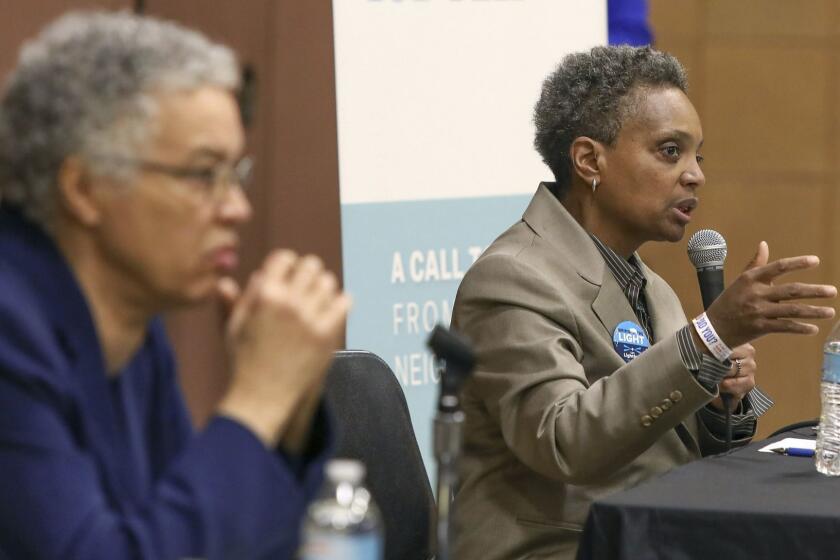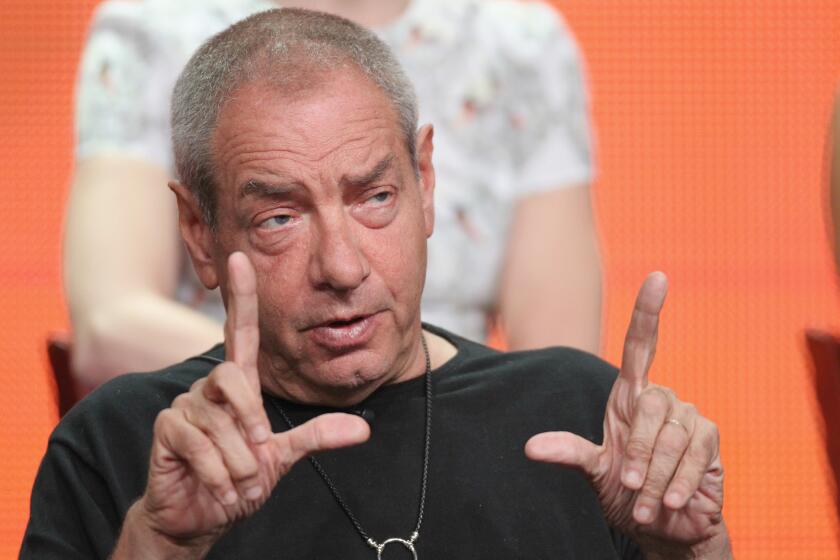Review: ‘City So Real’ beautifully lays out a Chicago mayoral race and its aftermath
- Share via
“City So Real,” a five-part documentary — more like four parts and a sequel — on Chicago’s 2018-19 mayoral race and our waning year of contagion and protest, is a beautiful tapestry of a series, an operatic cornucopia that makes something wonderful of our best and less best American selves. Unlike the 800-pound documentary series typically thrust upon us by the streaming giants — cults and criminals and criminal cults — to binge on and tweet about, it has not been arranged as if it were an exciting fiction, with mysteries and reveals and shocks to pull you along from episode to episode.
Nor, for that matter, does it recall any of those frankly fictional Dick Wolf series set in Chicago, whose stories of firemen/cops/doctors/lawyers in the Windy City of the Big Shoulders may contain a nubbin of truth, but tell you more about television than about life. And yet in its straightforward way it is perfectly thrilling, and its characters, major and minor, are vivid and complex and moving, and too organically themselves to have been imagined by the most talented scriptwriter. (Though a few of them could pitch up in an episode of “The Good Fight” and just start talking.)
Directed by Steve James, best known for the 1994 high school basketball documentary “Hoop Dreams,” and now streaming on Hulu after premiering Thursday on National Geographic Channel, it is dispassionate, but curious. It shows you things, in an interested way, without telling you how to feel about them (mostly; the musical soundtrack editorializes a little). Like all the best documentaries, it leaves with you as many questions as answers, and a healthy inkling that people are not easy to grasp, that every person represents a pair of shoes in which you haven’t walked.
Even at 5½ hours, “City So Real” is inevitably less than definitive, a slice of a city in a slice of time. (Some candidates are barely seen.) Still, it has a Dickensian — or maybe David Simon-ian — scope. Often painful, often enough funny, sometimes raucous, sometimes meditative, it is just here to show you some things that happened, in a carefully arranged bouquet. The series has some resonance with the work of Frederick Wiseman, whose “City Hall,” a 4½-hour film about institutional civics in Boston has also just been (virtually) released, in its long form, patient pace and way of moving from thread to thread. But unlike Wiseman, the filmmaker is an acknowledged presence in some scenes, less a fly on the wall than a fly on the wall who will buzz a direct question here and there.
It isn’t necessary to follow Chicago politics — I don’t, beyond whatever spills out into the national news, if I happen to be listening — to understand the dynamics of what’s happening here, or to follow the peculiar drama of the process itself. (The city has its own way of doing things.) But the political story is in any case just an expression of the greater human drama (and often comedy) James presents. Questions are asked, of the many candidates — some 17 in the mayor’s race to start — and their supporters and families, but James is more interested in how people represent themselves than whether what they say is true. (Even the seeming schemers, even the one actually under indictment, are secure in their quite different view of things; Chicago is a Democratic town, but not a politically monolithic one.)
Former federal prosecutor Lori Lightfoot was elected Chicago mayor on Tuesday, becoming the first black woman and first openly gay person to lead the nation’s third-largest city.
James stands back just far enough to let you see the life that swirls around the politics, to give you room to enter the frame, but not so far back as to make his pictures clinical. The protest footage is more immediate than what you typically see on the news, and also more subtle; you can feel things about to go wrong. Some compositions incidentally recall grand old history paintings, or a well-populated Brueghel canvas; at one press conference one’s eye goes to the small child running through the forest of adults. When Kanye West and Chance the Rapper make cameo appearance in support of candidate Amara Enyia, they look more ordinary, more life-sized than usual; the star energy is all in how people react to them. The photography throughout is beautiful — one might say respectful, and of subjects not always paid respect.
Chicago politics is, as someone says here, “a blood sport,” even if that is not how every candidate plays it — indeed, many are trying to move beyond the city’s famous history of corruption and cronyism, noted here. (Phrases like “The Parking Meter Deal” and “The Silver Shovel Investigation” are like something out of “Fargo.”) Among candidates too numerous to mention — the 17 running for mayor, others for alderman — there is a flamboyantly conservative businessman who’s got his own big band, the Dr. Willie Wilson Orchestra, moving through the city on a Sunday morning to drop off big checks at various churches, promising free hot chocolate to voters waiting in 5-degree weather “whoever you vote for.” (Even more colorful is his political advisor, Rickey “Hollywood” Hendon, a former alderman.)
As a Black lesbian, federal prosecutor Lori Lightfoot scores some intersectional firsts in Chicago history. Neal Salés-Griffin, a young tech entrepreneur and educator, whose campaign T-shirts read simply “Mayor,” because “Everybody should be mayor — you’re in charge, the mayor works for you,” has painted a map of all the city’s wards on his apartment wall. Former public school head Paul Vallas and a coterie of supporters film a promotional spot in front of City Hall, brandishing brooms to sweep it clean; his director would like more energy, “like storming the Bastille.”
Along with the election itself, the series returns to various themes, including the trial of police officer Jason Van Dyke for the shooting of Laquan McDonald, and the protests around that; the gentrification of a traditionally Latino neighborhood; and the proposed megadevelopment of the Lincoln Yards threatening the existence of a much-loved bar and venue, the Hideout, largely seen through the eyes of its owners, Katie and Tim Tuten. “We know that we are going against the captains of industry,” says Tim Tuten, about to give James’ series its title, “but we feel like in Chicago — ‘never a city so real’ — we’re the bar that Nelson Algren went to, we fight above our weight classes in Chicago.” (“Never a city so real” is a paraphrase of Algren’s description of the city: “Like loving a woman with a broken nose, you may well find lovelier lovelies. But never a lovely so real.”)
Critics say the popular TV shows of “Law & Order,” “Chicago PD” and “FBI” creator Dick Wolf create harmful misperceptions of the criminal justice system.
There are breaks from the main business to paint in the city at large, perhaps a little programatically at times — there are pictures of Halloween in a white neighborhood and a Black one, a Bears game watched in a white bar and a Black one, conversations in a Black barbershop and one that doubles as a hangout for white former cops, who run a little close to self-caricature. (There are even doughnuts.) Christmas comes to town and kids press faces to department store windows. Street musicians play. On Valentine’s Day, couples marry at City Hall.
The last episode jumps ahead to 2020 to revisit some of the characters we met in the earlier episodes and add a few new ones, looking at the city under its new mayor — all right, it’s Lightfoot, which you likely already knew — and how it’s coping with the pandemic and the protests and the response to the protests (and the violent hijacking of the protests). Once again, cards are laid on the table without nudging you to any kind of conclusion; people have things to say against or for her, and she has this to say:
“When I see the many ways in which people all over the city they pick themselves up, they literally dust themselves off, they sweep up the broken glass they restock the shelves, kids who are growing up in really challenging circumstances still have joy — how can I not have hope?”
Rated: TV-14
Where: Hulu (broadcast on National Geographic, Oct. 29-Nov. 2)
When: Any time
More to Read
The complete guide to home viewing
Get Screen Gab for everything about the TV shows and streaming movies everyone’s talking about.
You may occasionally receive promotional content from the Los Angeles Times.









